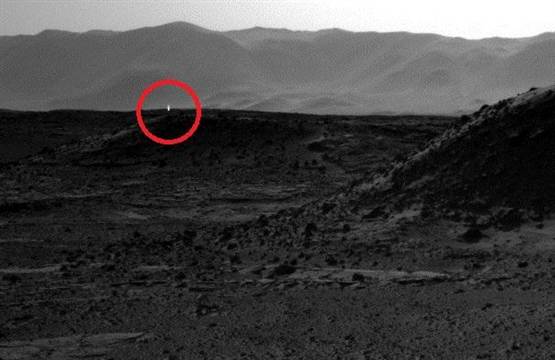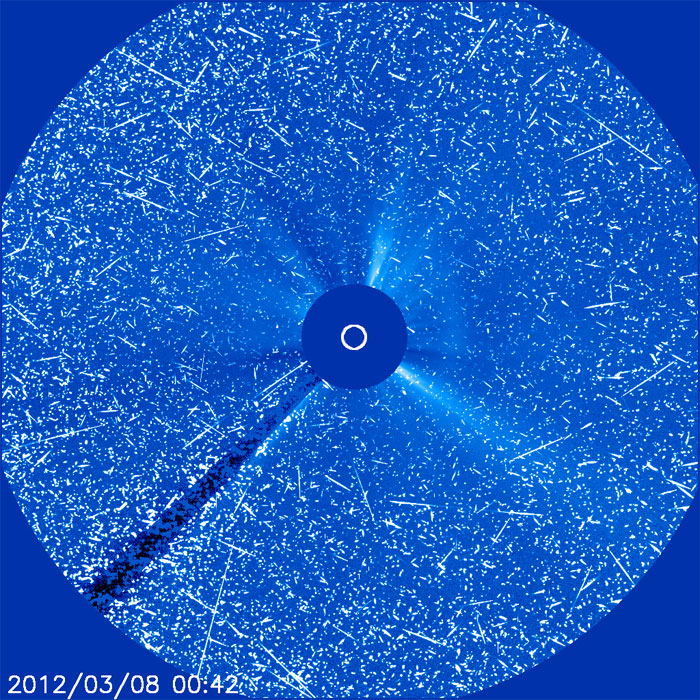.
Bright spots that look like a beacon flashing from a distant Martian hillside are attracting attention from the UFO crowd — but are they real or just photographic glitches?
The evidence so far favors a pixel dropout as the explanation, but the coincidence is curious enough to stir up chatter on websites such as Disclose.tv and UFO Sightings Daily. The webmaster for the latter site, Scott C. Waring, is having as much fun with this one as he had last year with the Mars Rat and the Martian Iguana.
"This could indicate that there is intelligent life below the ground and uses light as we do," Waring wrote in a posting about the pic on Sunday.
.

The red circle highlights a bright speck in a picture sent back from the right-hand navigation camera on NASA's Mars Curiosity rover on April 3.
.
The picture that caught Waring's eye was taken on April 3 by the right-hand navigation camera on NASA's Mars Curiosity rover as it was getting itself settled in a new study area known as the Kimberley. A bright speck that appears to flare upward can just be made out, right at the rim of a rise.
A picture taken by the right navcam on the day before shows a similar bright speck, seen from a slightly different perspective. The only problem is that the navigation camera is a stereo system, and the left-hand navcam doesn't show the bright spots on either day.
That suggests that the "light" might be a bit of lost data that left blank spots only on the right-hand navcam pictures. And it suggests that people are looking at the pictures from Curiosity very, very closely. If there's a message from Mars flashing in any photos, you can bet somebody's going to see it.
We've asked NASA's Jet Propulsion Laboratory to take a look at the pictures, and if we hear anything back, you'll find the update right here. Now, about that deer-cam UFO...
Update for 9 p.m. ET April 7: Doug Ellison, an imaging guru who happens to work at JPL, quickly told me in a Twitter update that the bright spot is due to a "cosmic ray hit" affecting the rover. (Later: The Surrey Space Center's Chris Bridges agrees.)
Quelle: NBC
.
Schaut man sich die nachfolgenden Aufnahmen an, ist der "Pixelfehler" immer nur auf der rechten Kamera gegenüber der linken Kamera von Stereo-Kamera von Curiosity;
.
Aufnahme vom 2.April - rechte Kamera
Aufnahme vom 2.April - linke Kamera
Aufnahme vom 3.April - rechte Kamera
Aufnahme vom 3.April - linke Kamera
.
Update:
.
'Mystery' Light on Mars Spotted by Curiosity (Update)
NBC's Alan Boyle has written a fascinating article about another theory as to what the mysterious Mars light is. Once again Curiosity has thrown us a curve ball -- one explanation revealed by a NASA scientist is that the light may be caused by the shiny surface of a rock as two Navcam images taken at different times appear to feature the same light.
"One possibility is that the light is the glint from a rock surface reflecting the sun," Justin Maki, imaging scientist at NASA's Jet Propulsion Laboratory, told Boyle. "When these images were taken each day, the sun was in the same direction as the bright spot, west-northwest from the rover, and relatively low in the sky."
Another explanation could be a spot of light leaking into the camera's housing through a vent hole. "We think it's either a vent-hole light leak or a glinty rock," said Maki.
He's not ruling out the cosmic ray explanation (below), but it is very curious that a similar spot of light should be present in two separate images, taken on two different days from the same instrument. But, no, it's still not aliens. Stay tuned for updates...
ORIGINAL POST: When trawling through raw photographs taken on the surface of an alien world, it may come as little surprise that occasionally we’ll see some mysterious objects and things that simply defy any rational explanation (at least initially).
Sadly, despite appearances, the above observation of the Martian landscape by NASA’s Mars rover Curiosity isn’t one of those photographs.
Attention was initially drawn to this image — taken by Curiosity’s Navigation Camera (Navcam) on Sol 589 of its mission (April 3) — by a UFO forum website, which, perhaps, may not come as a surprise. But then the story was given mainstream coverage by a breathless Houston Chronicle article titled: “NASA photo captures strange bright light coming out of Mars.”
The April 7 article writes about an “artificial light emanating outward from the planet’s surface” and quotes UFO enthusiast Scott C. Waring, who says: “This could indicate there there is intelligent life below the ground and uses light as we do. This is not a glare from the sun, nor is it an artifact of the photo process.” (Emphasis added for comedic effect.)
There’s a whole shedload of assumptions here, not least that the light is coming from some intelligent being on the surface of Mars and it uses light “as we do.” Is it an alien’s car headlight as the vehicle trundles toward the rover? Is it the flash of a Martian’s smartphone camera as the little guy snaps a selfie? The possibilities are endless.
However, the key problem with this entire line of reasoning is that the light is somehow “artificial.” It is not.
Punched by a Cosmic Ray
Space is filled with radiation and Mars’ thin atmosphere means that high-energy particles — a form of radiation known as cosmic rays that can originate from the sun or deep space phenomena — are not blocked as effectively as Earth’s comfortably thick atmosphere and meaty geomagnetic field. Therefore, some cosmic rays hit the surface of Mars.
What’s on the surface of Mars except rocks and dirt? Yes, Mars rovers and their very sensitive cameras.
The bright light that is suspiciously hanging over the horizon inside Gale Crater is not a light at all, it’s most likely a cosmic ray that hit Curiosity’s Navcam just as it was taking a photo.
Bad Astronomer Phil Plait and Emily Lakdawalla of the Planetary Society did a lot of the heavy lifting in this investigation and also drew the same conclusion that the “light” is in fact a cosmic ray hit. Be sure to read their detailed analysis.
The upshot is that a cosmic ray hit Curiosity’s Navcam. The camera has a charged-coupled device (CCD) array that converts optical light into an electrical signal (in pretty much the same way the digital camera on the back of your smartphone works). Should a high-energy particle like a cosmic ray hit the CCD, it can cause a temporary overload of charge, leaving a dot or a trail. (This should serve as a cautionary tale to digital camera manufacturers when they start shipping their wares to future Mars colonists — Mars selfies will often include ugly bright streaks, messing up the perfect shot.)
This is a very common artifact seen in raw space images. In my past research using solar images from space-based observatories (particularly the Solar and Heliospheric Observatory, or SOHO), these high-energy particle hits are a very common occurrence. With little to shield these observatory cameras from solar radiation, raw images of the sun are often peppered with dots and streaks. After image analysis and processing, these false signals can be easily removed.
Most of the time these cosmic ray hits look just like cosmic ray hits and even UFO enthusiasts can tell the difference. But in this case, the cosmic ray hit is positioned just on the brow of the undulating Martin landscape, providing a fertile scene for our brains to think there are aliens using flashlights on Mars.

An extreme example of high-energy particles hitting the CCD for the LASCO instrument on the NASA/ESA Solar and Heliospheric Observatory (SOHO).
.
Quelle: DNews
5076 Views

